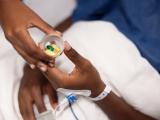Sep 23, 2010
Multidrug-resistant 2009 H1N1 virus reported in teenager
A 2009 H1N1 flu virus that contributed to the death of a 14-year-old girl was resistant to three neuraminidase inhibitors, pointing up the need for new types of antivirals, according to a letter in the Oct 15 Clinical Infectious Diseases (CID). The girl, who had systemic lupus erythematosus and other illnesses, was hospitalized with respiratory failure in October 2009. She was first treated with oseltamivir (Tamiflu) for several weeks and later with intravenous zanamivir (Relenza), but she died of complications in late December. Testing of samples taken in November showed that the virus was highly resistant to oseltamivir. It also showed evidence of resistance to peramivir and zanamivir, though to much lower degrees. Sequencing of the virus showed its neuraminidase protein contained two mutations: H275Y, which is known to confer resistance to oseltamivir but not zanamivir, and I223R. In one previous case, the I223R mutation alone was associated with slight resistance to oseltamivir and peramivir, the report says. Compared with strains featuring either mutation alone, the "dual mutant I223R/H275Y" showed greater resistance. "The potential for emergence of viruses resistant to multiple neuraminidase inhibitors reinforces efforts to develop drugs with a different mechanism of action," the report states.
Oct 15 CID letter
2009 H1N1 can gain Tamiflu resistance in less than 2 days
Physicians from Singapore say they determined that the 2009 H1N1 virus became resistant to oseltamivir in less than 48 hours after a 28-year-old woman began receiving the antiviral, much faster than reported in other cases, according to a report in Emerging Infectious Diseases (EID). The patient began receiving oseltamivir on the fourth day of her illness; the mutation that confers resistance (H275Y) was detected in a sample collected on the sixth day. Only wild-type (nonresistant) amino acid sequences were found in samples taken before and 14 hours after the start of oseltamivir treatment, but H275Y was found in 52% of the sequences from samples collected at 45 hours after treatment initiation. "Clinicians should consider resistance when patients do not respond to treatment for pandemic (H1N1) 2009 because H275Y can emerge literally overnight," the report states. Oseltamivir resistance has been seen sporadically in 2009 H1N1 patients, most commonly in immunocompromised patients receiving longer-than-normal courses of treatment.
October EID report
Early antivirals failed to protect some patients in Japan
Researchers writing in Clinical Infectious Diseases (CID) report that significant percentages of Japanese patients who had fatal or severe cases of 2009 H1N1 flu during the pandemic had received early antiviral treatment (oseltamivir or zanamivir). The researchers looked at all 198 fatal H1N1 cases reported to the Japanese health ministry from Aug 15, 2009, to Mar 15, 2010, and at 56 severe cases reported from Aug 5 to Oct 11, 2009, when the ministry stopped reporting the latter. Of the 298 fatal cases, 158 patients had received antivirals, and 104 of 158 (66%) started treatment within 1 or 2 days of first symptoms. Among the 56 severe cases, 42 patients had received antiviral treatment, 30 of them (71%) within the first 2 days. The median time to initiation of antiviral treatment was 1 day for both groups. "Although our observational data do not provide direct evidence of the effectiveness of antiviral treatment, our data clearly indicate that some severe cases had fatal outcomes despite their early treatment with antiviral drugs," the report says. The authors did not include information on the patients' previous health or underlying conditions.
Oct 15 CID letter
High rates of underlying conditions seen in H1N1 hospitalizations
Two new studies of patients who were hospitalized after contracting 2009 pandemic H1N1, one from Japan and one from Spain, found high percentages of underlying medical conditions. In the Japanese study, of 12,702 hospitalized patients, 4,420 (35%) had underlying medical conditions. But in those 5 to 9 years old, 81% had underlying conditions. For those with underlying conditions, incidence of hospitalization was 814.1, 573.7, and 219.0 per 100,000 persons for those 5 to 9, 10 to 14, and 15 to 19 years old, respectively; compared with only 6.7 for those 60 to 69. Those under 20 had a higher risk for hospitalization compared with seasonal flu. The researchers conclude, "Our findings justify prioritizing the treatment of children and young adults by vaccination and early prescription of antiviral drugs."
Sep 22 Emerg Infect Dis study
In the Spanish study, 74% of 3,025 hospital patients had underlying medical conditions, and, of all the patients, 852 (28%) were admitted to intensive care and 200 (7%) died. Among the children, 61% had underlying conditions, compared with 77% of adults. Among all patients 39% had two or more underlying conditions. The median age was 38. The researchers found these conditions to be "significantly associated with a worse outcome" in adults: morbid obesity, heart disease, chronic obstructive pulmonary disease, and receiving antiviral medication more than 48 hours after symptom onset. The authors conclude, "These findings should be taken into account when planning, including vaccination strategies, for upcoming influenza seasons."
Sep 23 Eurosurveillance study





















